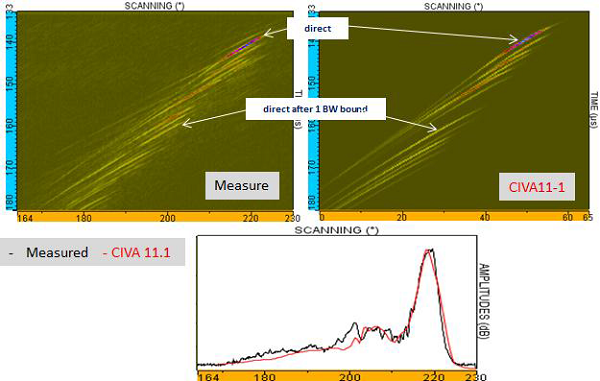Multiskip cylindrical: Measurement of the attenuation
The 3 CIVA parameters that determine the attenuation law for T waves and the 5 MHz probe are the attenuation coefficient « α », the exponent of the attenuation (« exponent ») and the frequency « f ».
Despite the fact that the 3 specimens described previously are from the same ingot, the attenuation of T waves changes from a mock-up to another when it is measured from the amplitude of T direct echoes of Ø3mm SDH of the calibration block. The process used to determine the attenuation has been revised as explained here after.
Calibration block
The attenuation parameters for the calibration block were obtained thanks to several simulations of T direct echoes of SDH where the 3 input parameters have been varied. After the computation of each simulation, a curve is plotted with:
- In abscissa: the round-trip realized in the specimen between the impact point of the probe’s T axis and the SDHs located at different depths.
- In ordinate: the maximal amplitudes of T direct echoes of the SDHs
The simulated curve has been compared to the experimental one. According to the result, the attenuation parameters have been adjusted in order to improve the agreement between the simulated and experimental curve. Finally, the 3 parameters that allowed to obtain the most faithful decrease compared to the experience are:
- attenuation coefficient: 0.085dB/mm
- attenuation exponent : 2
- frequency : 5MHz
The comparison between experimental and simulated results are presented below:

The evolution of the amplitude depending on the SDH depth with attenuation shows a good agreement between simulation and experiment..

Flat mock-up
Using the attenuation parameters of the calibration block for the defect response calculation in the flat specimen allowed to obtain simulated amplitudes of SDH and backwall breaking notch multiskip echoes lower than the experimental amplitudes.
Since CIVA predictions in these configuration are validated, the observed differences are due to attenuation parameters which are too high. Attenuation parameters for the flat mock-up do not correspond to the one of the calibration specimen. Therefore, attenuation parameters of the flat block were determined with the method used for the calibration block, that is to say by adjusting the value of the attenuation coefficient in order to obtain a good agreement between experimental and simulated amplitude curves of the SDH and notch multiskip echoes.
After successive adjustments of the attenuation coefficient, the parameters used to describe the attenuation of the flat specimen are:
- attenuation coefficient : 0.045dB/mm
- attenuation exponent: 2
- frequency : 5MHz
The attenuation coefficient in the flat mock-up is therefore much lower than the one obtained in the calibration specimen (0.085dB / mm).
The figure below shows the superposition of experimental and simulated curve.

Cylindrical specimen
As for the 2 previous mock-ups, the attenuation in the cylindrical part was obtained by adjusting the curves of experimental and simulated amplitude of SDH and notch multiskip echoes in the cylinder.

Simulations of multiple echoes of the SDH were performed with different attenuation coefficients, the 2 other parameters being constant (attenuation exponent: 2 and frequency: 5 MHz).
The amplitude curves of SDH echoes in function of the number of skips are shown on the figures below for respectively incidences of 16° and 19°:


For the incidence of 16°, the attenuation coefficient for which the simulated and experimental curves are in good agreement is 0.005dB / mm.
For incidence of 19°, several attenuation coefficients seem to agree because the 3 measured multiskip echoes are associated with short ultrasonic path for which the attenuation has little effect. There are not enough measurements to determine the value of the attenuation coefficient.
In the case of incidence of 16°, the superimposition of the measured and simulated echodynamic curves of SDH echoes shows significant differences. This calls into question the validity of the model for the calculation of these echoes. For this reason, the attenuation value of 0.005 dB/mm obtained by adjusting the experimental and simulated amplitudes of multiskip SDH echoes is not kept.

In the case of the incidence of 19°, the echodynamic curve of the direct echo is well predicted by CIVA but we only have 3 SDH echoes. It is insufficient for a precise fit since these first multiskip echoes, associated with short ultrasonic path in the specimen, are not sensitive enough to the value of the attenuation coefficient. Nevertheless, it should be noted that the attenuation coefficient of 0.025 dB/mm appears to be the one for which the simulated and experimental curves agree the best. Furthermore, using the responses of the SDH at the incidence of 19° is the most favorable configuration for estimation of the attenuation by simulation because there are no head wave generated on the surface of the cylinder.

Conclusion on attenuation measurement
Finally, the attenuation coefficients obtained are:
- 0.085 dB/mm for the calibration block
- 0.045 dB/mm for the flat specimen
Because we cannot determine the value of the attenuation coefficient in the cylindrical part, the simulations of the notch multiskip echoes are be performed with the attenuation coefficient of the flat specimen: 0.045dB / mm.
Continuer vers NOTCH: results obtained with a flat specimen
